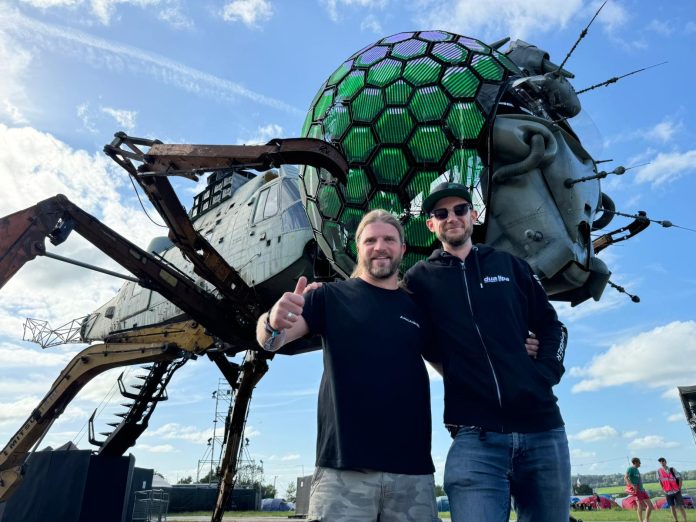
The Arcadia stage at Glastonbury Festival, presented annually by a uniquely talented collective of creatives, engineers, programmers and technicians, is one of the most recognised festival stages in the world.
This year, in place of its celebrated flame-throwing, laser-packed Spider, engineered from recycled heavy machinery, Arcadia unveiled The Dragonfly. The sculpture, which was built from a retired military helicopter and scrapped excavators, saw artists including Fat Boy Slim and Eric Prydz perform from its dazzling head. This, in turn, featured a pair of glittering compound eyes moulded from a tangram of video screens.
Video Illusions, as one of the Arcadia team’s long-term collaborators, was invited to design and manufacture a bespoke LED panel featuring a near-invisible structural framework and control. The brief further demanded that the screens be low-profile, IP-rated, and semi-transparent hexagonal and pentagonal shapes that could lock together. The objective? To evoke the solid form of The Dragonfly’s compound eyes, while enabling the transition from an opaque to transparent surface to reveal the performing DJ inside The Dragonfly’s head.
Dave Whiteoak, managing director of Video Illusions, said: “The moment I heard Arcadia’s brief for video, I had to call Ben Rushton-Vaughan of Cucumber Productions. I knew he was the ideal person to collaborate on the design and manufacture of a bespoke LED screen with such an exacting brief.”
Cucumber Productions’ Ben Rushton-Vaughan, added: “Dave and I designed a waterproof, super slim, 4mm thick LED panel. The 4mm spacing between pixels facilitated the semi-transparent effect Arcadia’s co-founders, Bertie Cole and Pip Rush, were looking for. The non-uniform curve of the structure and the modular nature of the screens created the organic form of The Dragonfly’s compound eyes.”
Katie Davies, Technical Production Manager for Arcadia at Glastonbury Festival, commented: “The custom-made hexagonal LED screen really brought The Dragonfly to life. Ben and Dave led on the design, fabrication and engineering to a very tight deadline. Nevertheless, delivery at Glastonbury went smoothly, and we were delighted with the result.”
As Rushton-Vaughan and Whiteoak attest, there were many sleepless nights figuring out the best way to design the panels. “Multiple versions of .DWG files were exchanged with Arcadia’s fabrication consultant, John Packer,” stated Whiteoak. “We were determined to avoid visible cable or structural framework.”
Remarkably, the teams didn’t see the result until everything arrived at the Glastonbury site and was assembled for the first time! However, the combined knowledge, experience, and skills in bespoke video solutions from Whiteoak and Rushton-Vaughan delivered a stunning outcome. Colleagues and friends from the video world were left scratching their heads and asking how it was even possible to create such a visually uncluttered LED panel in so little time. “If you have the passion, the experience, and the skills—plus a great team of techs and creatives, alongside a brave, boundary-pushing client—you can create almost anything,” Whiteoak remarked.
In addition to the LED design and fabrication, Whiteoak led his Video Illusions team with a meticulously planned cable infrastructure for the projection towers, and the video links between the HDMI over-fibre TX/ RX. A fellow long-standing supporter of Arcadia, CPL, supplied four BARCO UDX31k projectors.These took care of the projection onto the abdomen of The Dragonfly.
Meanwhile, Rushton-Vaughan took on the mantle of head of video, running all the technical aspects of the video system: “I ensured all our suppliers were aligned and oversaw the video system architecture,” explained Rushton-Vaughan. “I created the complex UV maps in Maxon’s Cinema 4D before importing them into Avolites Ai servers.”
Visual Art Director, Joe Crossley and his team from Astral Projekt designed and generated the video content using Touch Designer and Unity. Lighting Designer, Dave Cohen of MIRRAD supplied the Avolites Synergy system with their Ai QGen servers, operated by Avolites’ Arran Rothwell-Eyre. This enabled the team to merge video and LX into one cohesive medium. The legs of the Dragonfly were pixel-mapped in an Avolites D9-330, which took video signals from the AI server over synergy, extending the video canvas.
Video content was fed over NDI into the Ai servers, which live composited the two sources from Astral Projekt. This was then remapped, according to Rushton-Vaughan’s UV map, and output to the 178 hexagonal and 12 pentagonal screens, plus the projectors. A timecoded show also ran once a night, using pre-rendered content played directly from the Ai servers.”
To ensure clear communications across the site, Video Illusions installed a 360-degree CCTV system. This covered the whole structure, offering a sharp visual for all the technical programmers and operators, sited in various locations around the stage. Multiview monitors were positioned inside the Dragonfly’s body, in dimmer world, and at FOH. All ran via HDMI over fibre plus HMDI DA’s back-to-control.
Whiteoak and Rushton-Vaughan danced under the structure most nights, listening to festivalgoers’ reactions: “People were going crazy for it! They couldn’t work out where the visuals were coming from or how the lighting worked with the semi-transparent panels to give such a compelling holographic effect,” explained Whiteoak.
“People wanted their photo taken with us, with The Dragonfly’s eyes in the background,” he continued. “They were fascinated to learn about the collective of creative and technical engineers, programmers, and designers behind the scenes. It blew their minds.”
Both Rushton-Vaughan and Whiteoak say that The Dragonfly demonstrated that when you work with determined, curious, creative people with a diversity of skills and experiences, you can smash any idea out of the park.
After 15 years of the Arcadia Spider at Glastonbury, some were dubious that it could ever be replaced. Nevertheless, if the feedback from the artists that played The Dragonfly and the reviews in the music press are anything to go by, The Dragonfly has proved itself to be a worthy successor.
This is just the beginning for Arcadia’s latest venture,” Whiteoak and Vaughan said in unison. “Watch this space!”





